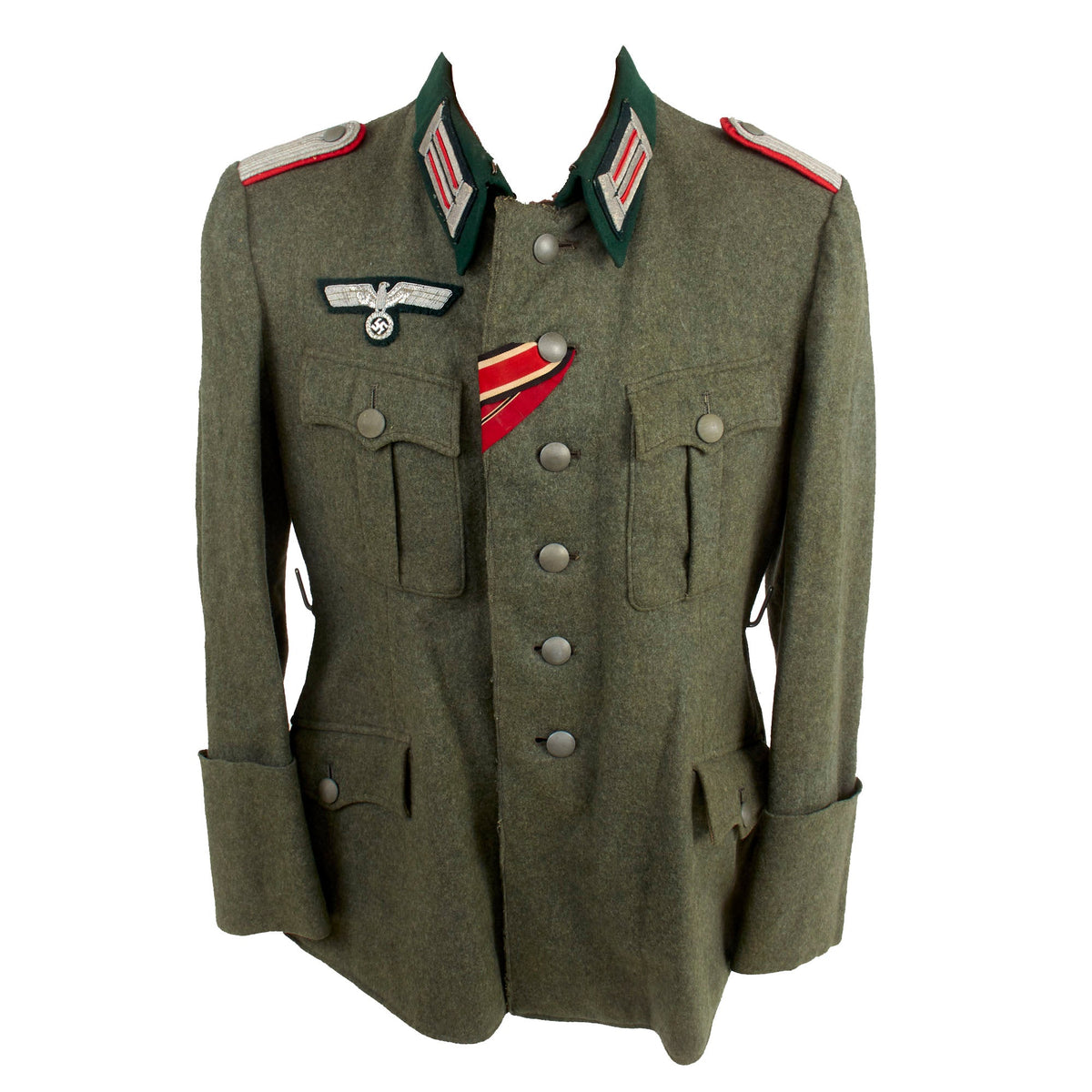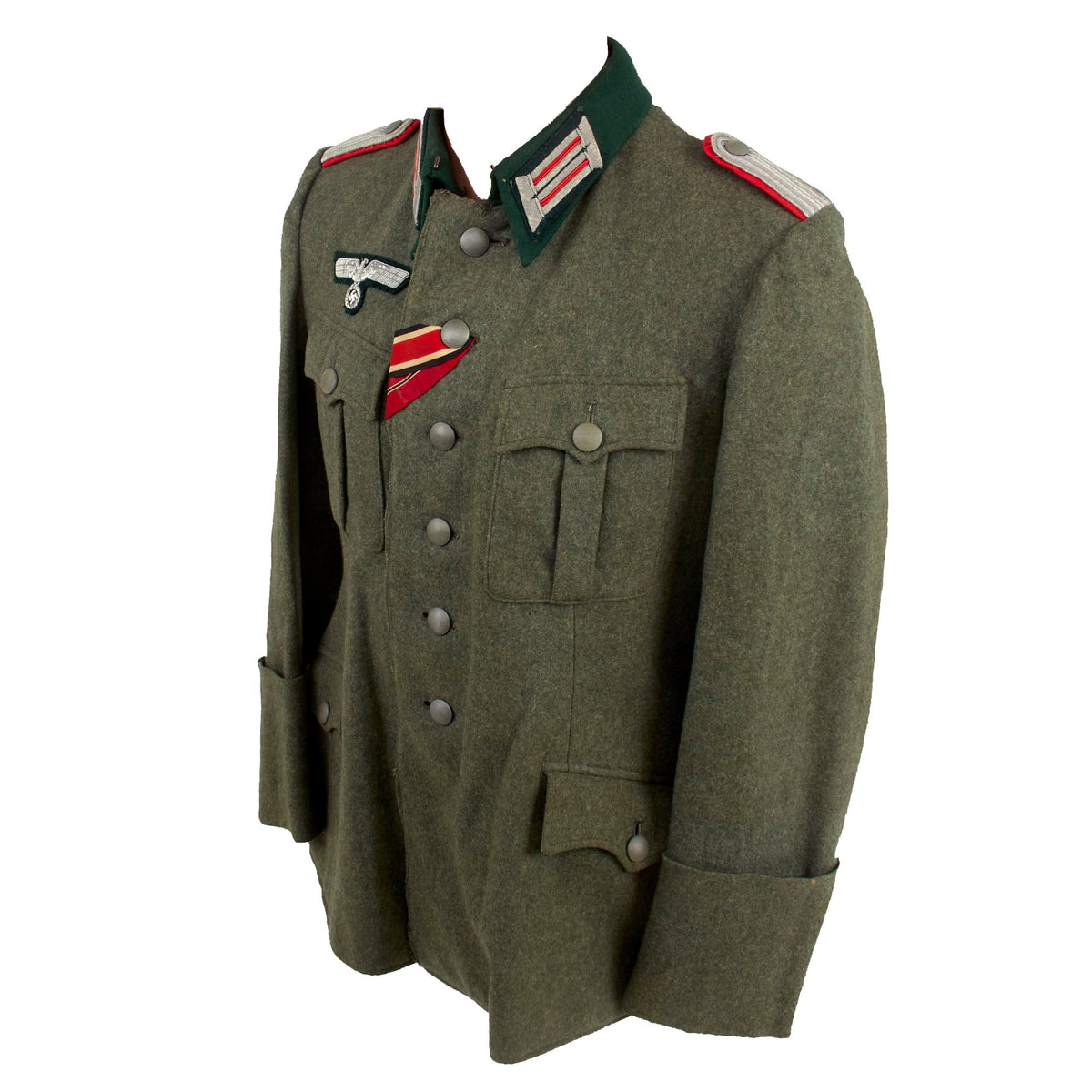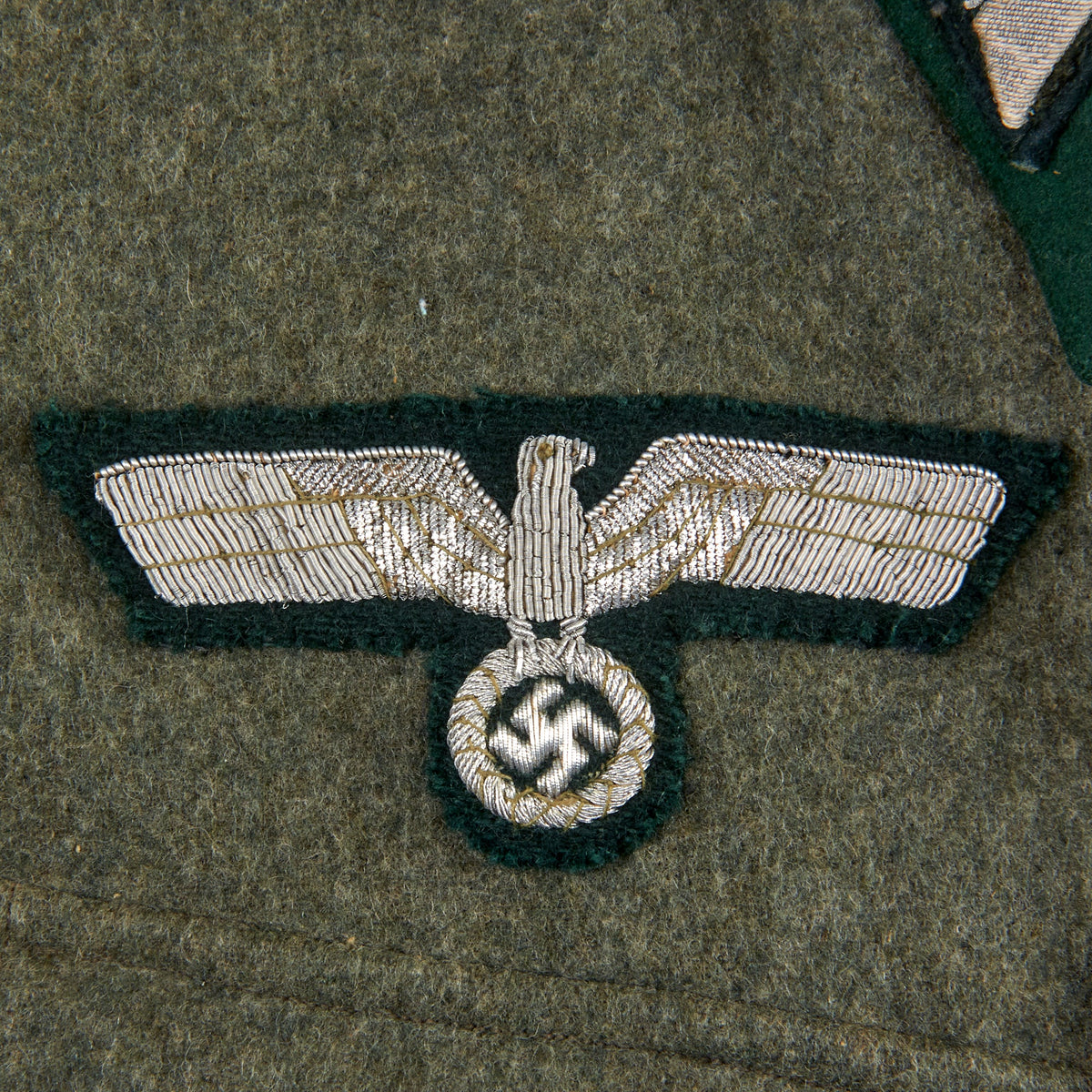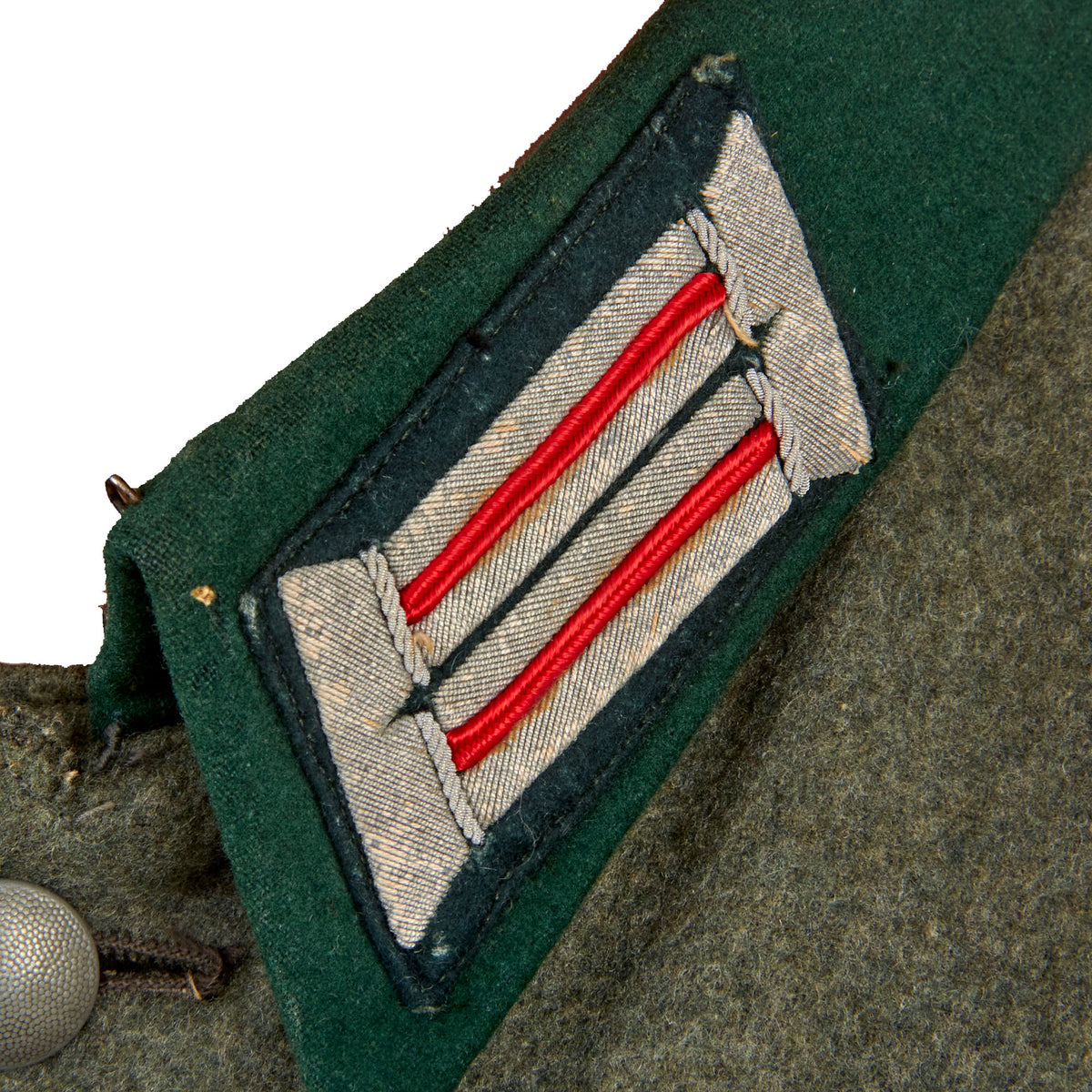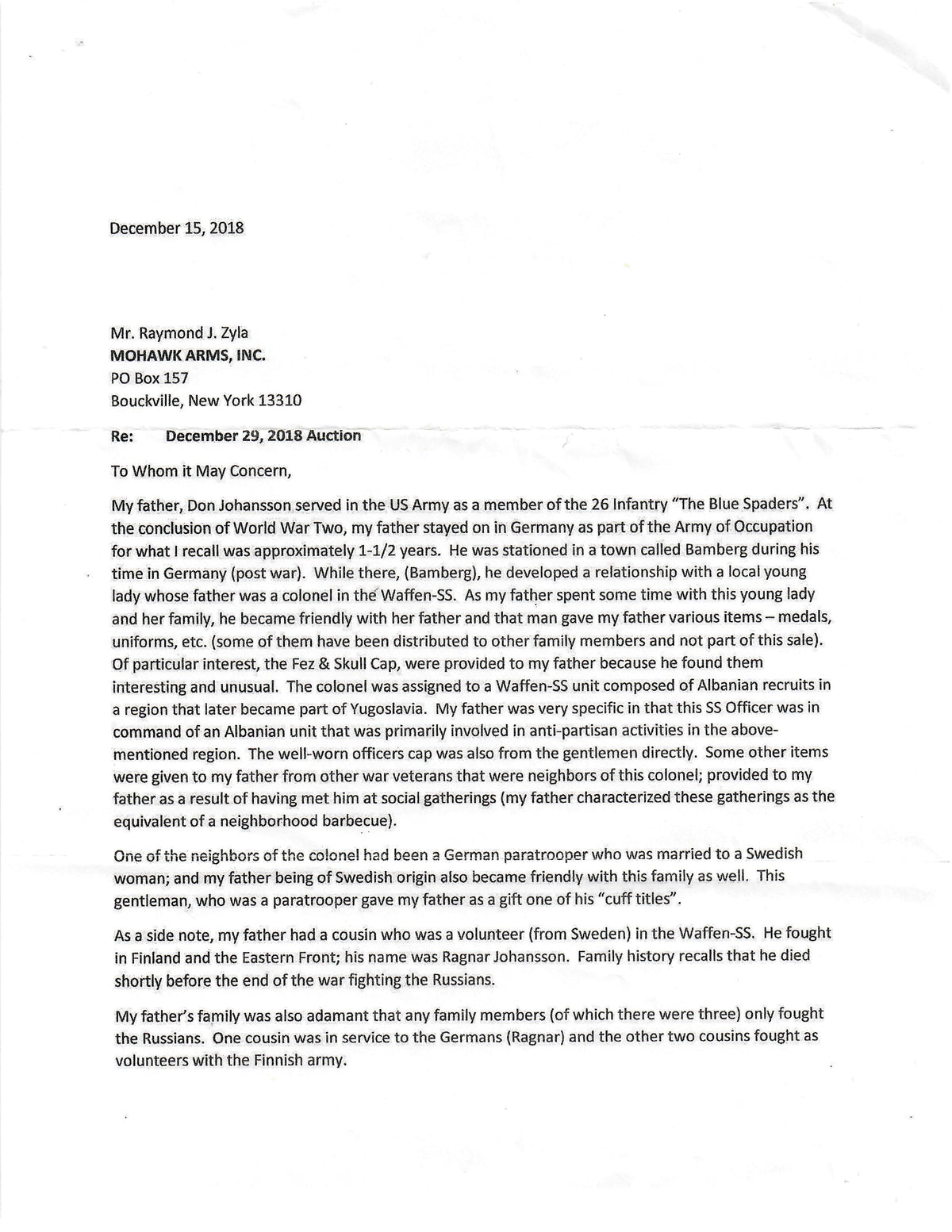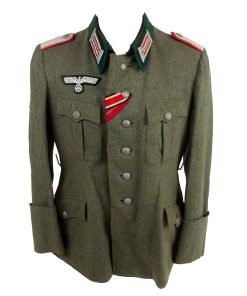Original German WWII Heer Artillery Leutnant Officer’s M36 Field Tunic with USGI Bring Back Documentation Original Items
$ 1.595,00 $ 398,75
Original Item: Only One Available. This is a very nice early pattern German WWII Heer Army Artillery Officer’s M-36 Tunic, showing moderate wear from service and in very good display condition. It was brought home by a USGI after the war, and comes with a copy of a signed affidavit from Carl L. Johansson along with a copy of a signed declaration from a Notary Public in California attesting that it was signed in their presence. The Tunic was listed previously at auction, and this is the documentation linking the uniform to Carl’s father, Don Johansson.
Per the affidavit, Don Johansson served in the U.S. Army as part of the 26th Infantry Regiment, known as “The Blue Spaders”, which during WWII was part of the 1st infantry division. They then stayed in Germany as part of the occupation force, and the Blue Spaders bore the United States national colors at the Allied Victory in Europe parade, and served as guards at Nuremberg War Crimes Trials. Thus began a lengthy stay in Germany, first as conquerors and later as friends and allies.
Johansson was part of this occupation force, and stayed in Germany for approximately 1-1/2 years, stationed in Bamberg, Germany, about 60km north of Nuremberg. While stationed there he became friendly with a lady whose father was a Colonel in the Waffen-SS, and got to know her father and family during his stay. The affidavit states that the father gave Johansson “various items – medals uniforms, etc.”, which appear to have been numerous. The father had been assigned to an Waffen-SS unit composed of Albanian volunteers, which we assume was the 21st Waffen Mountain Division of the SS Skanderbeg, which functioned in what would become Yugoslavia.
The affidavit also states that other items were given to Johansson by neighbors of this Waffen-SS Colonel, who had met him at local social gatherings, which were the “equivalent of a neighborhood barbecue.” Some specific examples are given related to items aside from the tunic, which we assume was acquired either from the father or from one his neighbors. The tunic in this offering was just one of many items which Don Johansson acquired during his time in Germany, and the information in the affidavit certainly gives some great historical background, as well as avenues for potential future research!
The M-36 tunic itself looks to be depot issued, and is marked with the standard size information on the inside of the left breast:
41 43
100
69 90 62
Under this is what looks to be a maker or depot marking, however we unfortunately cannot make out what it says.
The tunic features four pockets with scalloped flaps and pebbled magnetic buttons, which look to be made from galvanized stamped steel with zinc alloy backings and eyelets. The front closure features 6 of the same buttons on the right breast flap meeting an equal number of reinforced buttonholes on the left flap. There is also a hook and loop collar securing fastener, which is fully functional. The buttons all appear to be marked EXTRA FEIN on the back, however we cannot find any maker markings, and they are all sewn directly to the fabric.
The interior is lined with with a lovely olive / gray colored lightweight cotton twill fabric, while the sleeves are lined with the usual striped white cotton. There is an interior pocket inside the left breast, and there are a few minor tears and some light staining, but the interior is really in great shape otherwise. There is the usual slot for the officer’s dagger to hang out of the lower left pocket
It is adorned with the usual rank and branch insignia used on German tunics. The attractive Army breast eagle is the correct officer’s silver bullion hand embroidered type on a green background, and is very neatly hand stitched to the chest in a fashion typical of wartime German tailor work. It is only stitched to the outer layer of fabric, indicating installation when the uniform was made, so it has never been replaced. There is just a bit of fraying on the eagle due to wear.
The collar is wrapped in a dark-green wool, has officer’s field litzen collar patches on each side, which are woven from silver bullion thread with a dark green background matching the collar. The colored stripes on each are Hochrot (Deep Red) wool, the Waffenfarbe (Corps Color) during WWII for Artillery, as well as General Level Officers. As this is a company grade officer tunic, this is definitely for artillery, and Generals also did not use the Litzen collar insignia, instead using red and gold “Arabesque” insignia. The collar is in good shape, tough there is a bit of wear around the top edge, which is usually one of the first places to show damage from use.
The “sew-in” style company officers schulterklappen (shoulder boards) of this tunic are constructed with two rows of fine silver flatware “Russia Braid” double piping and have the correct red piping around the edges. There are no rank “pips” installed, indicating the lowest officer rank of Leutnant (2nd Lieutenant). The second buttonhole from the top on the tunic has the ribbons for the EKII and Eastern Front medal installed.
Overall condition is very good, with just a bit of light wear and staining consistent with service. We cannot see any major mothing or other issues with the uniform, just a few nips around the collar insignia. The litzen and shoulderboards also show some light wear. This is a uniform tunic that that saw light to moderate service during the war, and overall it displays very nicely.
A great documented USGI Bring Back from WWII, ready to research and display!
Approximate Measurements:
Collar to shoulder: 9.5″
Shoulder to sleeve: 25”
Shoulder to shoulder: 15.5”
Chest width: 18″
Waist width: 19″
Hip width: 23″
Front length: 29″
Terms such as M40 and M43 were never designated by the Wehrmacht, but are names given to the different versions of the Model 1936 field tunic by modern collectors, to discern between variations, as the M36 was steadily simplified and tweaked due to production time problems and combat experience.
Field Tunic (Feldbluse) Model 1936
When the NSDAP came to power in early 1933 the Reichswehr, the armed forces of the Weimar Republic, were near the end of a two-year project to redesign the Army Feldbluse (field-blouse). Beginning in that year the new tunic was issued to the Reichsheer and then the rapidly growing Wehrmacht Heer, although minor design changes continued to be made until the appearance of the standardized Heeres Dienstanzug Modell 1936. The M36 tunic still retained the traditional Imperial and Reichswehr uniform color of grey-green “field gray” (feldgrau) wool, but incorporated four front patch pockets with scalloped flaps and pleats (on Reichswehr tunics the lower pockets were internal and angled). The front was closed with five buttons rather than the previous eight, and the collar and shoulder straps were of a dark bottle-green instead of the Reichswehr grey. Compared to the Weimar-era uniforms the skirt of the feldbluse was shorter and the tailoring was more form-fitting due to Germany’s adoption of mechanized warfare: soldiers now spent much time in the confined space of a vehicle and a shorter jacket was less likely to pick up dirt from the seats. It also included an internal suspension system, whereby a soldier could hang an equipment belt on a series of hooks outside of the tunic. These hooks were connected to two straps inside the lining, which spread the weight of equipment without having to use external equipment suspenders. The M36 was produced and issued until the very end of the war, though successive patterns became predominant.
SS field uniforms were of similar appearance externally but to fit their larger patches had a wider, feldgrau collar, and the lower pockets were of an angled slash type similar to the black or grey SS service-dress. The second button of an SS Feldbluse was positioned somewhat lower, so that it could be worn open-collar with a necktie. Due to supply problems the SS were often issued army uniforms.
Fast Shipping with Professional Packaging
Thanks to our longstanding association with UPS FedEx DHL, and other major international carriers, we are able to provide a range of shipping options. Our warehouse staff is expertly trained and will wrap your products according to our exact and precise specifications. Prior to shipping, your goods will be thoroughly examined and securely secured. We ship to thousands clients each day across multiple countries. This shows how we're dedicated to be the largest retailer on the internet. Warehouses and distribution centres can be located throughout Europe as well as the USA.
Note: Orders with more than one item will be assigned a processing date depending on the item.
Before shipping before shipping, we'll conduct a thorough inspection of the items you have ordered. Today, the majority of orders will be delivered within 48 hours. The delivery time will be between 3-7 days.
Returns
The stock is dynamic and we cannot completely manage it because multiple stakeholders are involved, including our factory and warehouse. So the actual stock may alter at any time. It's possible that you may not receive your order once the order has been made.
Our policy is valid for a period of 30 days. If you don't receive the product within 30 days, we are not able to issue a refund or an exchange.
You can only return an item if it is unused and in the same state as the day you received it. You must have the item in its original packaging.
Related products
Uncategorized
Armored Burgonet Helmet & Polearm from Scottish Castle Leith Hall Circa 1700 Original Items
Uncategorized
Uncategorized
Uncategorized
Australian WWII Owen MK1 Machine Carbine SMG Custom Fabricated Replica with Sling Original Items
Uncategorized
Uncategorized
Uncategorized
Uncategorized
Uncategorized
Uncategorized
Uncategorized
Uncategorized
Uncategorized
Uncategorized
Uncategorized
Uncategorized
Uncategorized
Uncategorized
Armoured Fighting Vehicles of the World: AFVs of World War One (Hardcover Book) New Made Items
